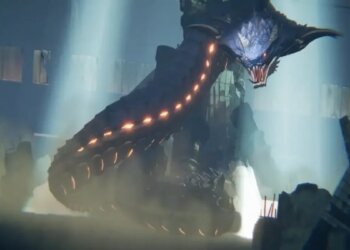At the Nintendo Switch 2 showcase, there were many exciting new experiences to dive into, but one particular presentation captured my attention: Metroid Prime 4: Beyond. Despite the array of novel announcements, it was this familiar title that stood out to me.
During the brief demo available for Metroid Prime 4, I found myself immersed in an area of the game that felt stripped down, likely a scenario from the very start. As a series enthusiast, I predict this takes place before Samus upgrades her power suit with telekinetic abilities. For now, she wields her standard arm cannon, missiles, scanner, morph ball, and bombs—tools any Metroid fan would recognize in an instant. This stripped-back setup initially makes Prime 4 seem like a straightforward continuation of its predecessors, though there’s a promise of additional depth with new abilities and mechanics hinted at in other footage, which we didn’t get to explore this hands-on session.
There’s a method to Nintendo and Retro Studios’ choice of showcasing this particular segment. It’s straightforward and allows players to appreciate how the core essence of Metroid Prime translates onto the new Switch 2 hardware without the distraction of new mechanics.
As I settled in for the demo, a Nintendo representative promptly informed me, “This is running at 120 frames per second.” Hearing Nintendo emphasize performance metrics straight away was a surprise, as it’s not typically their style. But it’s clear why—seeing Metroid Prime 4 on the Switch 2 with such fluidity and clarity is an impressive sight.
The game is essentially an upgraded version meant for Switch 2, an improvement over hardware purportedly substantially weaker according to Nvidia’s numbers. On the Switch 2, it runs in full HD (4K available but capped at 60fps), maintaining a smooth 120 frames, outclassing the visuals from even the original Switch streams, which weren’t available for direct comparison at this event. The whole experience feels refreshingly unlike the typical Nintendo approach, transforming expectations once you start playing.
The introduction of the new Joy-Con feature, similar to using a PC mouse when placed on a flat surface, opens exciting gameplay possibilities. By simply repositioning the right Joy-Con, the game smoothly transitions to mouselook, bypassing any need for menu adjustments. This feature integrates seamlessly—perfect for a genre that inherently blends metroidvania exploration with first-person shooting dynamics.
Elsewhere at the event, Civilization 7’s implementation of these mouse controls mirrored its PC version, demonstrating this new Switch 2 capability’s broad application. In Metroid Prime 4, this approach feels even more innovative. While holding both Joy-Con in traditional fashion, it plays like any other in the series. However, when the right Joy-Con is moved into a ‘mouse’ position, it instantly shifts to a mouselook experience without any hassle—it’s intuitive and effective.
In the demo, combat was the highlight, with puzzle solving taking a backseat. But within half an hour, I found a rhythm. Using the Joy-Cons as a controller for scanning and morph ball navigation felt natural. Yet, in intense combat moments, using the Joy-Con as a mouse unleashed the accurate, rapid aiming akin to PC gaming—a powerful combo for tackling challenges, especially when facing bosses with precise vulnerabilities.
It was during these combat sequences, and notably a boss fight relying on pinpoint targeting, that the combination of high frame rates and precise control truly shined. It felt almost illicitly advantageous—performance and accuracy in a Nintendo game traditionally seemed like a far-off dream.
If Metroid Prime 4 sets the tone for what’s to come, it points toward a future where performance takes precedence on the Switch 2 without sacrificing the visual quality that’s become synonymous with Nintendo titles. When the game officially launches later, while an original Switch version may be available, the Switch 2 is unequivocally the way to go for the full experience. This aligns with exactly what you’d expect—and hope for—from a next-gen leap.








































